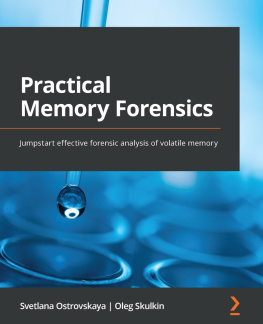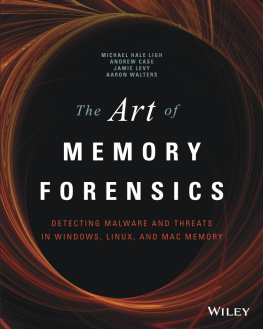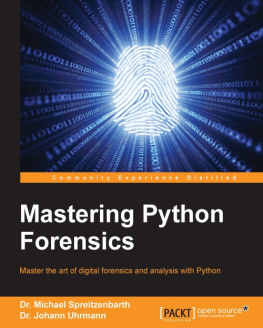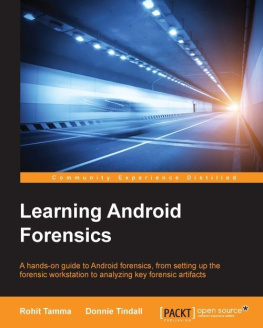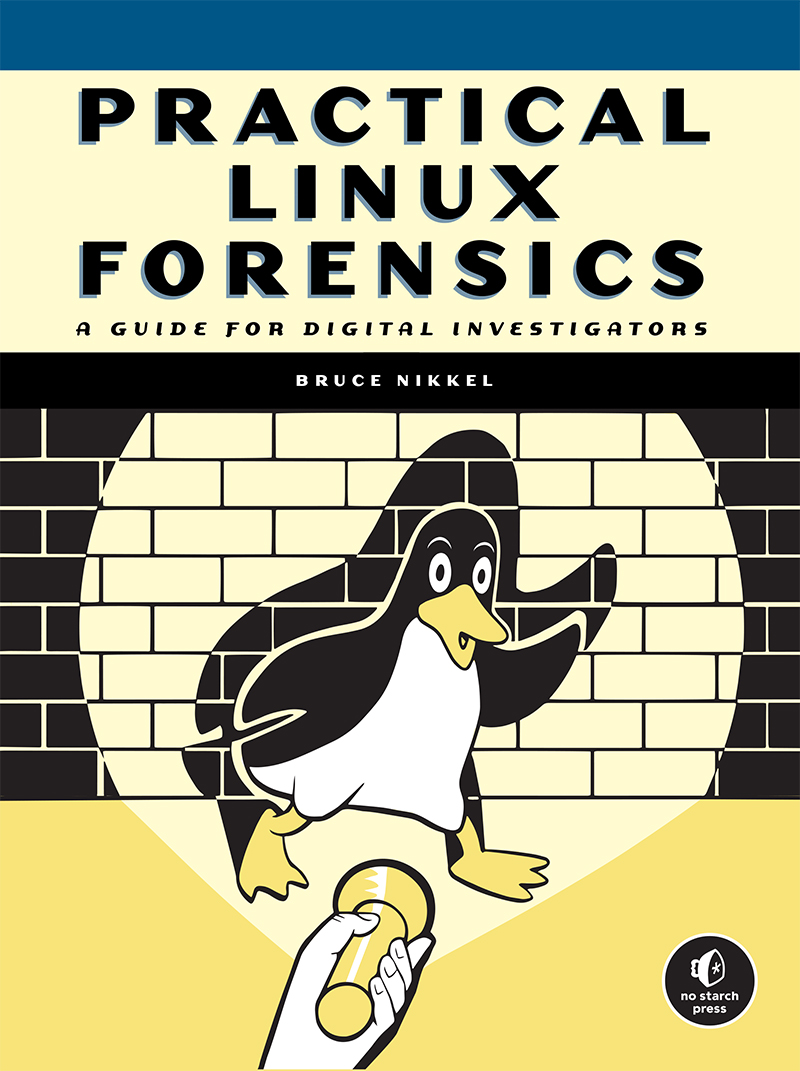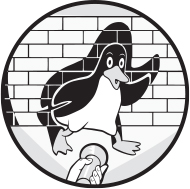PRACTICAL LINUX FORENSICS
A Guide for Digital Investigators
by Bruce Nikkel
San Francisco
PRACTICAL LINUX FORENSICS. Copyright 2022 by Bruce Nikkel
All rights reserved. No part of this work may be reproduced or transmitted in any form or by any means, electronic or mechanical, including photocopying, recording, or by any information storage or retrieval system, without the prior written permission of the copyright owner and the publisher.
Printed in the United States of America
First printing
25 24 23 22 21 1 2 3 4 5 6 7 8 9
ISBN-13: 978-1-7185-0196-6 (print)
ISBN-13: 978-1-7185-0197-3 (ebook)
Publisher: William Pollock
Managing Editor: Jill Franklin
Production Manager: Rachel Monaghan
Production Editor: Miles Bond
Developmental Editor: Jill Franklin
Interior and Cover Design: Octopod Studios
Cover Illustrator: James L. Barry
Technical Reviewer: Don Frick
Copyeditor: George Hale
Production Services: Octal Publishing, Inc.
For information on book distributors or translations, please contact No Starch Press, Inc. directly:
No Starch Press, Inc.
245 8th Street, San Francisco, CA 94103
phone: 1.415.863.9900;
www.nostarch.com
Library of Congress Cataloging-in-Publication Data
Names: Nikkel, Bruce, author.
Title: Practical Linux forensics : a guide for digital investigators / by
Bruce Nikkel.
Description: San Francisco : no starch press, [2022] | Includes index. |
Identifiers: LCCN 2021031364 (print) | LCCN 2021031365 (ebook) | ISBN
9781718501966 (paperback) | ISBN 9781718501973 (ebook)
Subjects: LCSH: Digital forensic science. | Linux. | Computer
crimesInvestigation. | Data recovery (Computer science)
Classification: LCC HV8079.C65 N56 2022 (print) | LCC HV8079.C65 (ebook)
| DDC 363.25/968dc23
LC record available at https://lccn.loc.gov/2021031364
LC ebook record available at https://lccn.loc.gov/2021031365
No Starch Press and the No Starch Press logo are registered trademarks of No Starch Press, Inc. Other product and company names mentioned herein may be the trademarks of their respective owners. Rather than use a trademark symbol with every occurrence of a trademarked name, we are using the names only in an editorial fashion and to the benefit of the trademark owner, with no intention of infringement of the trademark.
The information in this book is distributed on an As Is basis, without warranty. While every precaution has been taken in the preparation of this work, neither the author nor No Starch Press, Inc. shall have any liability to any person or entity with respect to any loss or damage caused or alleged to be caused directly or indirectly by the information contained in it.
[S]
This book is dedicated to everyone who provided motivation, support, guidance, mentoring, inspiration, encouragement, critiques, wisdom, tools, techniques, and researchall of which influenced and helped with the creation of this book.
About the Author
Bruce Nikkel is a professor at the Bern University of Applied Sciences in Switzerland, specializing in digital forensics and cybercrime. He is co-head of the universitys research institute for cybersecurity and engineering, and director of the masters program in Digital Forensics and Cyber Investigation. In addition to his academic work, he has worked in risk and security departments at a global financial institution since 1997. He headed the banks Cybercrime Intelligence & Forensic Investigation team for more than 15 years and currently works as an advisor. Bruce holds a PhD in network forensics, is the author of Practical Forensic Imaging (No Starch Press, 2016), and is an editor with Forensic Science Internationals Digital Investigation journal. He has been a Unix and Linux enthusiast since the 1990s.
About the Technical Reviewer
Don Frick started his career as an IT forensics consultant for a Big Four firm, collecting evidence and conducting investigations for clients across Europe, and eventually came to lead the Forensic Technology team based in Zurich. He later moved to New York to open a forensic lab for a major global financial institution. As part of the banks Cybercrime Intelligence & Forensic Investigation team, he has worked on a wide range of investigations. He enjoys tinkering with hardware and different operating systems (Linux, macOS, Windows) in his free time.
CONTENTS IN DETAIL
INTRODUCTION
Welcome to Practical Linux Forensics: A Guide for Digital Investigators. This book covers a variety of methods and techniques for finding and analyzing digital evidence found on modern Linux systems. Among digital forensic investigators, the phrase Linux forensics may have one of two meanings. In one case, it refers to using Linux as a digital forensics platform to perform acquisition or analysis of any target system under investigation (which could be Windows, Mac, Linux, or any other operating system). In this book, however, Linux forensics refers to analyzing or examining a suspect Linux system as the target of an investigation (independent of the platform or tools used).
I will focus on identifying common artifacts found on various Linux distributions (distros) and how to analyze them in the context of a forensic investigation. The forensic analysis methods described in this book are independent of the tools used and will benefit users of FTK, X-Ways, EnCase, or any other forensic analysis tool suite. The tools I use in the examples and illustrations tend to be Linux-based, but the concepts remain fully tool independent.
Why I Wrote This Book
In some ways, this book is a logical continuation of my first book, Practical Forensic Imaging (No Starch Press, 2016). After performing a forensic acquisition of a system and securing a drive image, analysis is the next step performed in a typical digital forensic investigation. This book dives into the technical details of analyzing forensic images of Linux systems.
There are many books on Windows and even Mac forensic analysis, but few books focus on the analysis of a Linux system as the target of an investigation. Even fewer focus specifically on postmortem (dead disk) analysis of modern Linux installations. Ive been hearing digital forensic investigators in the community increasingly comment: We are starting to get more Linux images in our lab, but we dont know exactly what to look for. Such comments are coming both from forensic labs in the private sector (corporations) and the public sector (law enforcement). This book is intended to provide a resource that addresses this growing area of interest. It will help forensic investigators find and extract digital evidence found on Linux systems, reconstruct past activity, draw logical conclusions, and write comprehensive forensic evidence reports of their analysis.
Another reason for writing this book is out of personal interest and motivation to better understand the internals of modern Linux systems. Over the past decade, significant advancements in Linux distributions have changed how Linux forensic analysis is performed. I teach classes in both digital forensics and Linux at the Bern University of Applied Sciences in Switzerland, and writing this book has helped me stay current on those topics.


